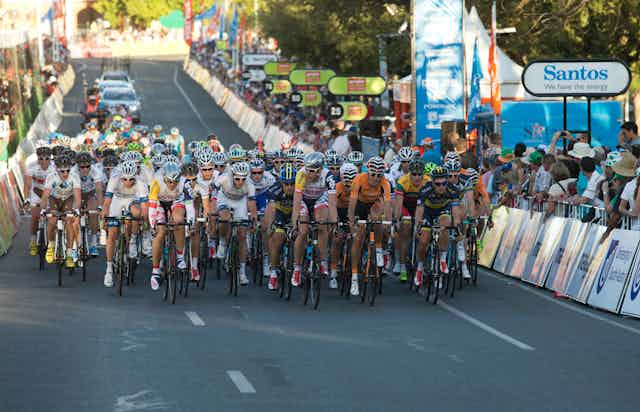Amid the mountains of words written in Australia about Lance Armstrong’s recent interview with Oprah Winfrey, there has been surprisingly little serious debate about what this case means for how we should respond to drugs and doping in Australian cycling.
In the run-up to the interview, the public reaction, media and expert commentary ranged from speculation about whether Armstrong would confess at all, to what he might confess and the likely costs, to his selfish motivations and, bizarrely, to armchair diagnoses of narcissistic personality disorder.
But what the policy-makers and officials in Australian cycling do in the wake of this story is far more critical for the future of the sport in this country than it is Armstrong’s fate.
There are some very significant things happening in the policy landscape of Australian cycling that deserve attention.
Sports Minister Kate Lundy and Cycling Australia are currently considering their response to the recently released Wood Review of Cycling Australia.
The Wood review has recommended a range of anti-doping measures, including improved governance structures, more extensive testing and sanctions, better education, an ethics and integrity panel, and better rider support systems.
The Australian Sports Anti-Doping Authority (ASADA) has also been busy since last November, undertaking its own investigations into doping activity in cycling – calling for riders past and present to come forward with information about rules violations.
Curiously, the ASADA investigation is offering no punishment amnesty for past episodes of anti-doping rule violations, although under the World Anti-Doping Code individual whistle-blowers may be given “substantial assistance” in the form of reduced sentences.
Stricter drug testing and surveillance protocols, and harsher penalties for athletes returning confirmed positive test results, look like good policy responses to drugs and doping in cycling. And the best available evidence suggests the general public and many athletes support such measures.
But we should be careful that, in our post-Armstrong rush to harden anti-doping approaches in Australia, we don’t find ourselves on a one-way path to a war on drugs in cycling and other sports.
There are already concerning signs. Over the last few months there has been an escalation in the official rhetoric around drugs in cycling policy, with Cycling Australia, ASADA and the Federal Sports Minister all issuing calls for greater punishments for cyclists who test positive.
The governance architecture is now being put in place to support such moves. A memorandum of understanding between ASADA and the Australian Crime Commission was brokered by the Sports Minister in late 2012. And the Wood Cycling Australia Review, mentioned above, has just outlined further options to extend and strengthen drug testing and sanctions.
The problem with this is we know from our experiences with illicit drugs, and other areas of health, that lasting changes in behaviour are rarely brought about through an over-emphasis on prohibition and punishment, or other forms of individual naming and shaming.
Instead we need approaches that aim to achieve cultural change at the group level. To do this requires that we understand the culture in question – a challenging enough task made more difficult by the absence of honesty.
This is the crux of the problem before us now. There is a lack of understanding of the culture and traditions of competitive cycling. And, unfortunately, precious few people in cycling are coming clean about this culture.
Lance Armstrong has been portrayed as being at the centre of the culture of doping and cheating in international professional cycling. But Armstrong was right when he told Oprah “I didn’t invent the culture”.
Drugs and doping have been a part of competition cycling since its earliest days, internationally and here in Australia.
If we care to look closely, it is possible to see that the drugs in sport issue is never just about the individual. The use of drugs and other performance-enhancing methods in sport, as in other domains of life, is influenced by the historical context, and the environment, cultures, and people around us. No-one uses drugs in a social vacuum.
Further, the choice to use performance-enhancing drugs is rarely just about one person’s desire to gain advantage. Such choices are motivated by a complex mix of factors including the quest for personal enhancement and pushing performance limits, pain management, recovery, career longevity, economic gains, and a desire to belong.
Bodies such as Cycling Australia and ASADA do excellent work in responding to the use of drugs and doping in Australian cycling. Even better results are possible on that front in the future, but the gains won’t come through punishments.
A better way forward is via a World Anti-Doping Agency-authorised amnesty where individuals who have participated in, or have knowledge about doping in cycling can volunteer such information with immunity. An amnesty with full absolution would allow us to take a broader, more informed view that brings us to an understanding of the cultural conditions and determinants of sports doping.
This would deliver greater policy returns than restricting the focus of our spotlight on individuals such as Lance Armstrong and others like him that are sure to follow.
The recent doping admissions by the past Australian riders Matt White and Stephen Hodge looked like a welcome precedent for honesty about drugs in Australian cycling. Regrettably, the tough-on-drugs approach looming now in Australia for cycling and sport generally will probably work against this.
There is no doubt that a type of truth will emerge from this approach. But it will be incomplete and incapable of informing better policy.

